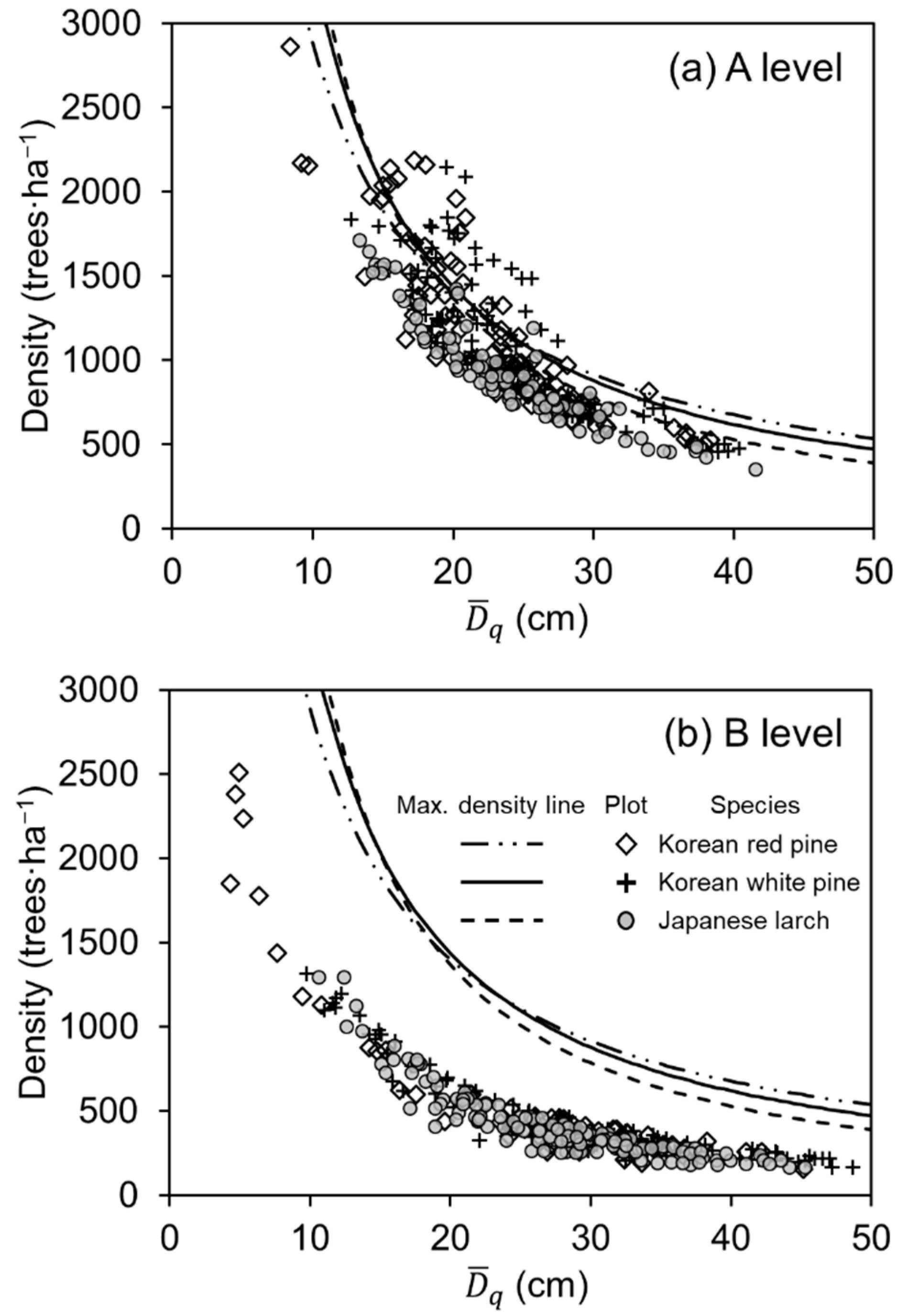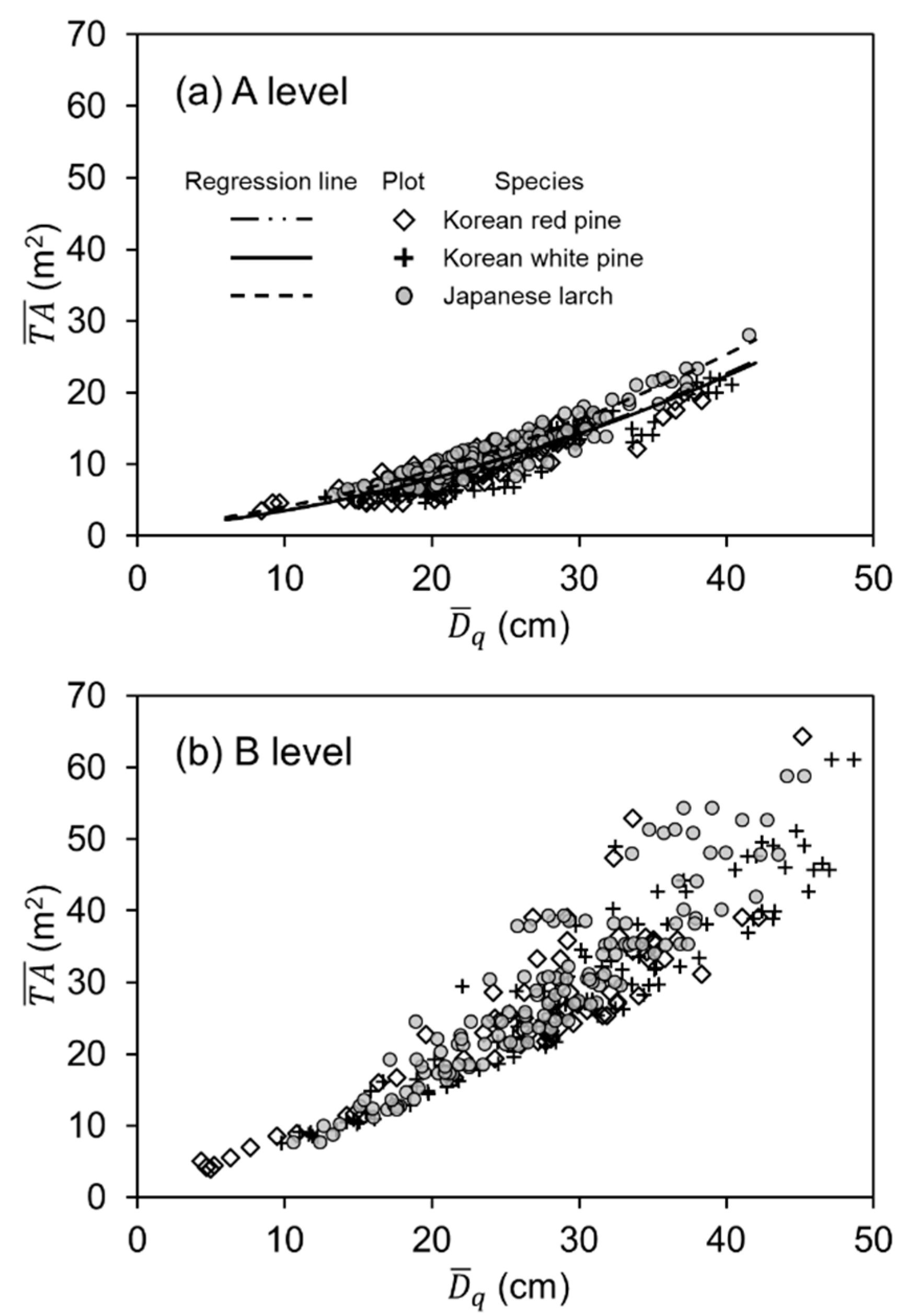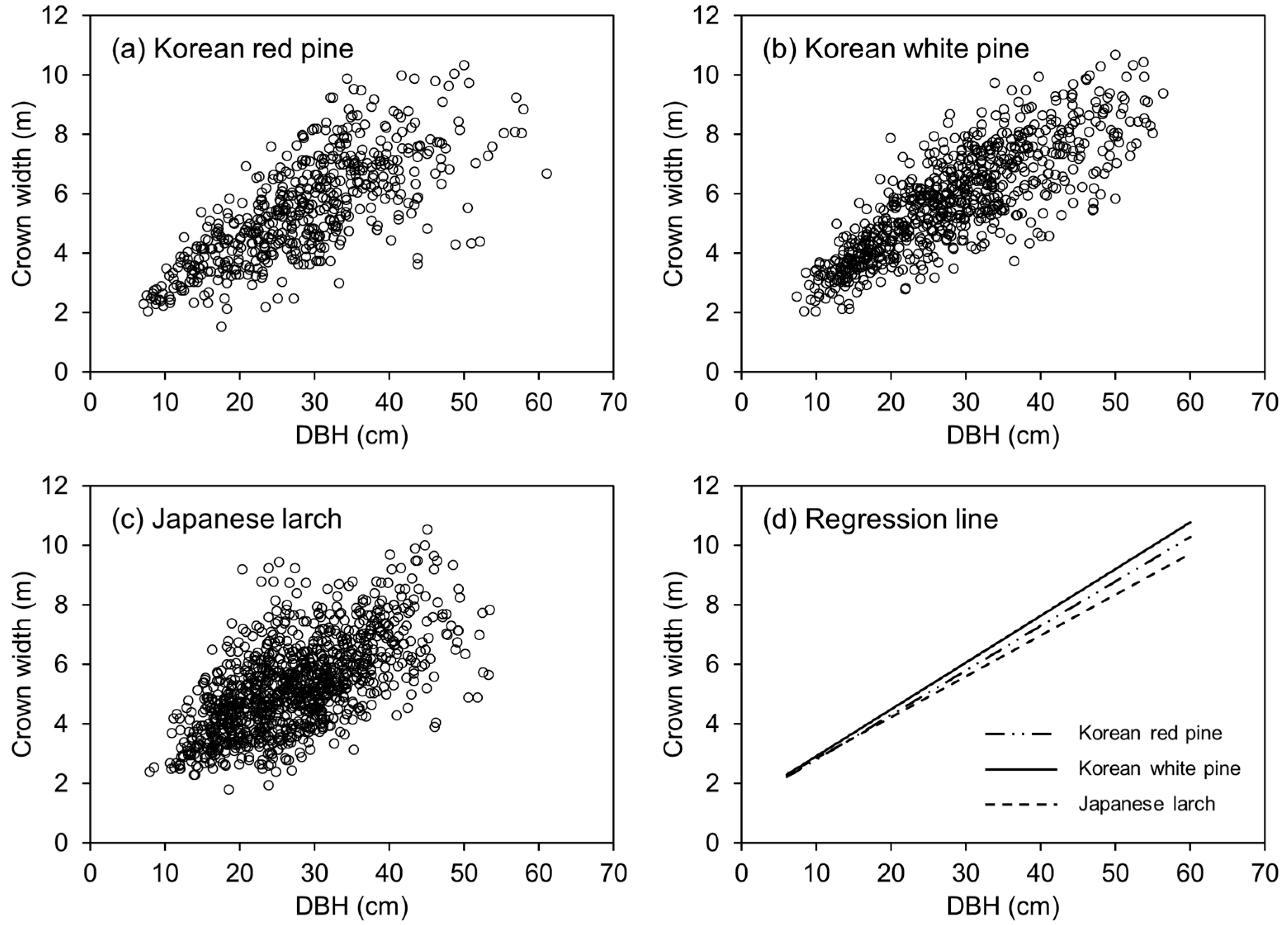Stocking Diagrams for Silvicultural Guideline in Korean Pines and Japanese Larch
Abstract
1. Introduction
2. Materials and Methods
2.1. Data
2.1.1. Plot and Tree Measurement
2.1.2. Maximum Density in Fully Stocked Stands (A-Level Stocking)
2.1.3. Minimum Density in Fully Stocked Stands (B-Level Stocking)
2.2. Tree Allometric Equations
2.2.1. Minimum Tree Area in Fully Stocked Stands (for A-Level Stocking)
2.2.2. Crown Area on Open-Grown Sites (for B-Level Stocking)
2.3. Statistical Analysis
3. Results
3.1. Parameter Estimates and Tree Allometric Descriptions
3.2. Illustration and Comparison of Stocking Diagram Applications
4. Discussion
4.1. Suitability of Gingrich-Style Stocking Chart
4.2. Practicability and Applicability of the Stand Density Management Diagram
5. Conclusions
Author Contributions
Funding
Acknowledgments
Conflicts of Interest
References
- Ernst, R.L.; Warren, P.A. Forest Stand Density and Stocking: Concepts, Terms, and the Use of Stocking Guides; WO GTR-44; US Forest Service: Washington, DC, USA, 1985; p. 8.
- McGill, D.W.; Rogers, R.; Martin, A.J.; Johnson, P.S. Measuring stocking in northern red oak stands in Wisconsin. North. J. Appl. For. 1999, 16, 144–150. [Google Scholar] [CrossRef]
- Lhotka, J.M.; Loewenstein, E.F. An examination of species-specific growing space utilization. Can. J. For. Res. 2008, 38, 470–479. [Google Scholar] [CrossRef]
- Puettmann, K.J.; Hann, D.W.; Hibbs, D.E. Evaluation of the size-density relationships for pure red alder and Douglas-fir stands. For. Sci. 1993, 39, 7–27. [Google Scholar] [CrossRef]
- Kara, F.; Loewenstein, E.F.; Lhotka, J.M.; Kush, J.S. A gingrich-style stocking chart for longleaf pine (Pinus palustris Mill.) forests. For. Sci. 2018, 64, 307–315. [Google Scholar] [CrossRef]
- Gingrich, S.F. Measuring and evaluating stocking and stand density in upland hardwood forests in the Central States. For. Sci. 1967, 13, 38–53. [Google Scholar] [CrossRef]
- Larsen, D.R.; Dey, D.C.; Faust, T. A stocking diagram for midwestern eastern cottonwood-silver maple-American sycamore bottomland forests. North. J. Appl. For. 2010, 27, 132–139. [Google Scholar] [CrossRef]
- Zeide, B. How to measure stand density. Trees 2005, 19, 1–14. [Google Scholar] [CrossRef]
- Zeide, B. Comparison of self-thinning models: An exercise in reasoning. Trees 2010, 24, 1117–1126. [Google Scholar] [CrossRef]
- Goelz, J. A stocking guide for southern bottomland hardwoods. South. J. Appl. For. 1995, 19, 103–104. [Google Scholar] [CrossRef]
- Goelz, J. Stocking guides for water tupelo and baldcypress. South. J. Appl. For. 1995, 19, 105–108. [Google Scholar] [CrossRef]
- Larsen, D.R. Spreadsheet stocking diagrams for the central hardwoods. North. J. Appl. For. 2002, 19, 93–94. [Google Scholar] [CrossRef]
- Newton, P.F. Stand density management diagrams: Review of their development and utility in stand-level management planning. For. Ecol. Manag. 1997, 98, 251–265. [Google Scholar] [CrossRef]
- Seymour, R.S. Low-Density management of white pine crop trees: A primer and early research results. North. J. Appl. For. 2007, 24, 301–306. [Google Scholar] [CrossRef][Green Version]
- Korea Forest Research Institute. Commercial Tree Species 1 Korean Red Pine (Pinus densiflora Siebold & Zucc.); Korea Forest Research Institute: Seoul, Korea, 2012; p. 250. (In Korean) [Google Scholar]
- Korea Forest Research Institute. Commercial Tree Species 3 Korean white Pine (Pinus koraiensis Siebold & Zucc.); Korea Forest Research Institute: Seoul, Korea, 2012; p. 168. (In Korean) [Google Scholar]
- Korea Forest Research Institute. Commercial Tree Species 4 Japanese Larch (Larix kaempferi (Lamb.) Carriere); Korea Forest Research Institute: Seoul, Korea, 2012; p. 180. (In Korean) [Google Scholar]
- Kim, D.C. Stand density and optimum growing stock of Korean red pine forest in Kwangwon district. J. Korean For. Soc. 1963, 3, 47–51. (In Korean) [Google Scholar]
- Ma, S.K. Productivity and density control of stands of Japanese larch. J. Korean For. Soc. 1977, 34, 21–30. [Google Scholar]
- Ando, T. Growth analysis on the natural stands of Japanese red pine (Pinus densiflora Sidb Et Zucc). II. Analysis of stand density and growth. Bull. Gov. For. Exp. Stn. 1962, 147, 1–77, (In Japanese with English Summary). [Google Scholar]
- Ando, T. Ecological growth analysis on the natural stands of Japanese red pine (Pinus densiflora Sidb Et Zucc). II. Analysis of stand density and growth. Bull. Gov. For. Exp. Stn. 1968, 210, 1–153, (In Japanese with English Summary). [Google Scholar]
- Shim, D.S.; Park, C.W.; Lee, H.K.; Kim, S.I. A study on stand density management diagram of Korean white pine (Pinus koraiensis) stands. Res. Rep. For. Res. Inst. Korea 1985, 32, 38–48, (In Korean with English Summary). [Google Scholar]
- Shim, D.S.; Park, C.W.; Lee, H.K.; Kim, S.I. A study on stand density management diagram of Japanese larch (Larix leptolepis) stand. Res. Rep. For. Res. Inst. Korea 1986, 33, 1–12, (In Korean with English Summary). [Google Scholar]
- Kim, D.K.; Kim, J.W.; Park, S.K.; Oh, M.Y.; Yoo, J.H. Growth analysis of natural pure young stand of red pine in Korea and study on the determination of reasonable density. Res. Rep. For. Res. Inst. Korea 1987, 34, 32–40, (In Korean with English Summary). [Google Scholar]
- Park, J.H.; Lee, K.S.; Yoo, B.O.; Park, Y.B.; Jung, S.Y. Development and validation of the stand density management diagram for Pinus densiflora forests in Korea. J. Korean For. Soc. 2016, 105, 342–350. [Google Scholar] [CrossRef]
- Park, J.; Jung, S.; Yoo, B.; Lee, K.; Park, Y.; Kim, H. The production objectives and optimal standard of density control using stand density management diagram for Pinus densiflora forests in Korea. J. Korean For. Soc. 2017, 106, 457–464. [Google Scholar] [CrossRef]
- Lee, D.; Choi, J. Evaluating maximum stand density and size–density relationships based on the competition density rule in Korean pines and Japanese larch. For. Ecol. Manag. 2019, 446, 204–213. [Google Scholar] [CrossRef]
- Choi, J.; Lorimer, C.G.; Vanderwerker, J.; Cole, W.G.; Martin, G.L. A crown model for simulating long-term stand and gap dynamics in northern hardwood forests. For. Ecol. Manag. 2001, 152, 235–258. [Google Scholar] [CrossRef]
- Choi, J.; Lorimer, C.G.; Vanderwerker, J.M. A simulation of the development and restoration of old-growth structural features in northern hardwoods. For. Ecol. Manag. 2007, 249, 204–220. [Google Scholar] [CrossRef]
- Curtis, R.O.; Marshall, D.D. Why quadratic mean diameter? West. J. Appl. For. 2000, 15, 137–139. [Google Scholar] [CrossRef]
- Johnson, P.S.; Shifley, S.R.; Rogers, R. The Ecology and Silviculture of Oaks; CABI Publishing: New York, NY, USA, 2002; p. 503. [Google Scholar]
- Chisman, H.H.; Schumacher, F.X. On the tree-area ratio and certain of its applications. J. For. 1940, 38, 311–317. [Google Scholar] [CrossRef]
- Avery, T.E.; Burkhart, H.E. Forest Measurements, 5th ed.; McGraw-Hill: New York, NY, USA, 2002; p. 456. [Google Scholar]
- Stout, S.L.; Larson, B.C. Relative Stand Density: Why do we Need to Know? USDA Forest Service General Technical Report INT-243: USDA Forest Service; Intermountain Forest and Range Experiment Station: Ogden, UT, USA, 1988; pp. 73–79. [Google Scholar]
- Long, J.N. A practical approach to density management. For. Chron. 1985, 61, 23–27. [Google Scholar] [CrossRef]
- Shaw, J.D.; Long, J.N. A density management diagram for longleaf pine stands with application to red-cockaded woodpecker habitat. South. J. Appl. For. 2007, 31, 28–38. [Google Scholar] [CrossRef]
- Solomon, D.S.; Zhang, L. Maximum size–density relationships for mixed softwoods in the northeastern USA. For. Ecol. Manag. 2002, 155, 163–170. [Google Scholar] [CrossRef]
- Lee, D.S. Integrated Growth and Yield Models of Pinus densiflora, Pinus koraiensis, and Larix kaempferi Stands in Korea. Ph.D. Thesis, Kangwon National University, Chuncheon, Korea, 2018; p. 155. [Google Scholar]
- Krajicek, J.E.; Brinkman, K.A.; Gingrich, S.F. Crown competition—A measure of density. For. Sci. 1961, 7, 35–42. [Google Scholar]
- Sampson, T.L. A Stocking Guide for Northern Red Oak in New England. Master’s Thesis, University of New Hampshire, Durham, UK, 1983; p. 98. [Google Scholar]
- Sampson, T.L.; Barret, J.P.; Leak, W.B. A Stocking Chart for Northern Red Oak in New England; University of New Hampshire, New Hampshire Agricultural Experiment Station Report no. 100: Durham, NH, USA, 1983; p. 14. [Google Scholar]
- Stout, B.B. Crown-Stem Relationships in Forest Trees; Rutgers University: New Brunswick, NJ, USA, 1963; Unpublished work. [Google Scholar]
- Stout, B.B. Stem-Crown relationships in scots pine. In Proceedings of the Northeastern Forest Tree Improvement Conference, New Brunswick, NJ, USA, 6–7 August 1963; Volume 11. [Google Scholar]
- Kara, F.; Topaçoğlu, O. Onset of canopy closure for black pine, Turkish red pine and Scots pine forests. J. For. Sci. 2018, 64, 224–229. [Google Scholar] [CrossRef]
- Grégoire, T.G.; Schabenberger, O.; Barrett, J.P. Linear modelling of irregularly spaced, unbalanced, longitudinal data from permanent-plot measurements. Can. J. For. Res. 1995, 25, 137–156. [Google Scholar] [CrossRef]
- Hall, D.B.; Clutter, M. Multivariate multilevel nonlinear mixed effects models for timber yield predictions. Biometrics 2004, 60, 16–24. [Google Scholar] [CrossRef]
- Bianchi, S.; Siipilehto, J.; Hynynen, J. How structural diversity affects Norway spruce crown characteristics. For. Ecol. Manag. 2020, 461, 117–932. [Google Scholar] [CrossRef]
- SAS Institute Inc. SAS/STAT 14.1 User’s Guide; SAS Institute Inc.: Cary, NC, USA, 2015. [Google Scholar]
- Korea Forest Research Institute. Standard Manual of Sustainable Forest Resources Management; Korea Forest Research Institute: Seoul, Korea, 2005; p. 291. (In Korean) [Google Scholar]
- Chang, C.S. Relationship between growth of individual trees and surrounding density in larch stands (Larix leptolepis). J. Korean For. Soc. 1985, 71, 27–32, (In Korean with English Summary). [Google Scholar]
- Korea Forest Research Institute. Stem Volume, Biomass, and Yield Table; Korea Forest Research Institute: Seoul, Korea, 2012; p. 261. (In Korean) [Google Scholar]
- National Institute of Forest Science. Empirical Yield Table; National Institute of Forest Science: Seoul, Korea, 2016; p. 64. (In Korean) [Google Scholar]
- Williams, R.A. Use of stand density index as an alternative to stocking percent in upland hardwoods. North. J. Appl. For. 2003, 20, 137–142. [Google Scholar] [CrossRef]





| Dataset Use | Criterion for Selecting Data Sources | Species | Sample Size | Variables | Mean | SD | Minimum | Maximum |
|---|---|---|---|---|---|---|---|---|
| Maximum density on full stocking (A-level stocking) | Relative density >0.7 | Korean red pine | 98 plots | Stand age (year) | 51 | 18 | 12 | 105 |
| Average DBH (m) | 22.0 | 6.1 | 8.2 | 37.2 | ||||
| Quadratic mean diameter (cm) | 23.2 | 6.2 | 8.4 | 38.4 | ||||
| Stand density (trees·ha−1) | 1170 | 499 | 500 | 2860 | ||||
| Basal area (m2·ha−1) | 43.4 | 10.3 | 14.5 | 74.0 | ||||
| Korean white pine | 118 plots | Stand age (year) | 43 | 13 | 18 | 83 | ||
| Average DBH (m) | 23.9 | 5.8 | 12.5 | 39.5 | ||||
| Quadratic mean diameter (cm) | 24.6 | 5.9 | 12.7 | 40.4 | ||||
| Stand density (trees·ha−1) | 1074 | 396 | 453 | 2144 | ||||
| Basal area (m2·ha−1) | 46.3 | 10.8 | 23.4 | 76.4 | ||||
| Japanese larch | 128 plots | Stand age (year) | 42 | 12 | 19 | 66 | ||
| Average DBH (m) | 23.6 | 6.0 | 13.0 | 41.0 | ||||
| Quadratic mean diameter (cm) | 24.2 | 6.1 | 13.3 | 41.5 | ||||
| Stand density (trees·ha−1) | 931 | 317 | 356 | 1714 | ||||
| Basal area (m2·ha−1) | 38.7 | 8.0 | 23.9 | 61.7 | ||||
| Minimum density on full stocking (B-level stocking) | Relative density <0.5 | Korean red pine | 543 trees in 50 plots | Age (year) | 48 | 21 | 12 | 105 |
| DBH (cm) | 28.3 | 10.4 | 5.3 | 61 | ||||
| Crown width (m) | 5.4 | 1.8 | 1.1 | 10.4 | ||||
| Korean white pine | 755 trees in 68 plots | Age (year) | 41 | 18 | 18 | 82 | ||
| DBH (cm) | 28.5 | 10.8 | 7.3 | 56.3 | ||||
| Crown width (m) | 5.8 | 1.8 | 2.1 | 10.7 | ||||
| Japanese larch | 1118 trees in 105 plots | Age (year) | 41 | 13 | 22 | 65 | ||
| DBH (cm) | 27.1 | 8.6 | 7.9 | 53.4 | ||||
| Crown width (m) | 5.2 | 1.5 | 1.8 | 10.6 |
| Model Type | Equation | Species | Sample Size | Fixed Effects | Random Effects | Residual | Fit Statistics | ||||
|---|---|---|---|---|---|---|---|---|---|---|---|
| RMSE | |||||||||||
(for A-level stocking) | Equation (8) | Korean red pine | 98 plots | 0.9153 (0.1183) | 0.0962 (0.0048) | 0.0230 | 0.0178 | - | 0.0217 | 0.9680 | 0.1101 |
| Korean white pine | 118 plots | 0.9221 (0.1364) | 0.0951 (0.0052) | 0.0385 | 0.0111 | - | 0.0129 | 0.9798 | 0.0857 | ||
| Japanese larch | 128 plots | 1.0262 (0.0851) | 0.1002 (0.0034) | 0.0047 | 0.0151 | - | 0.0162 | 0.9713 | 0.1025 | ||
| CW – DBH (for B-level stocking) | Equation (9) | Korean red pine | 543 trees | 1.3099 (0.2269) | 0.1496 (0.0057) | 0.3910 | 0.0000 | 0.2572 | 0.8398 | 0.7537 | 0.8794 |
| Korean white pine | 755 trees | 1.3452 (0.1968) | 0.1572 (0.0054) | 0.2761 | 0.0000 | 0.2329 | 0.6027 | 0.8208 | 0.7451 | ||
| Japanese larch | 1118 trees | 1.4669 (0.1928) | 0.1375 (0.0054) | 0.4928 | 0.0926 | 0.1108 | 0.7889 | 0.6862 | 0.8555 | ||
© 2020 by the authors. Licensee MDPI, Basel, Switzerland. This article is an open access article distributed under the terms and conditions of the Creative Commons Attribution (CC BY) license (http://creativecommons.org/licenses/by/4.0/).
Share and Cite
Lee, D.; Choi, J. Stocking Diagrams for Silvicultural Guideline in Korean Pines and Japanese Larch. Forests 2020, 11, 833. https://doi.org/10.3390/f11080833
Lee D, Choi J. Stocking Diagrams for Silvicultural Guideline in Korean Pines and Japanese Larch. Forests. 2020; 11(8):833. https://doi.org/10.3390/f11080833
Chicago/Turabian StyleLee, Daesung, and Jungkee Choi. 2020. "Stocking Diagrams for Silvicultural Guideline in Korean Pines and Japanese Larch" Forests 11, no. 8: 833. https://doi.org/10.3390/f11080833
APA StyleLee, D., & Choi, J. (2020). Stocking Diagrams for Silvicultural Guideline in Korean Pines and Japanese Larch. Forests, 11(8), 833. https://doi.org/10.3390/f11080833






